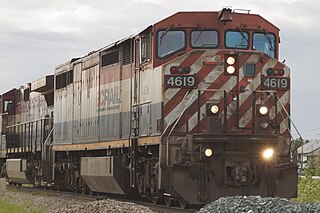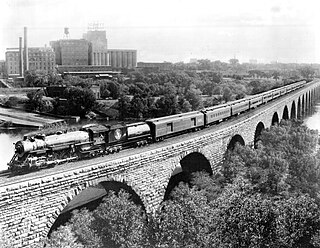
The Great Northern Railway was an American Class I railroad. Running from Saint Paul, Minnesota, to Seattle, Washington, it was the creation of 19th-century railroad entrepreneur James J. Hill and was developed from the Saint Paul & Pacific Railroad. The Great Northern's route was the northernmost transcontinental railroad route in the U.S.

BC Rail is a railway in the Canadian province of British Columbia.

Under the Whyte notation for the classification of steam locomotives, 4-6-2 represents the wheel arrangement of four leading wheels on two axles, six powered and coupled driving wheels on three axles and two trailing wheels on one axle. The 4-6-2 locomotive became almost globally known as a Pacific type after a New Zealand locomotive that was shipped across the Pacific Ocean.

Under the Whyte notation for the classification of steam locomotives, 4-8-4 represents the wheel arrangement of four leading wheels on two axles, eight powered and coupled driving wheels on four axles and four trailing wheels on two axles. The type was first used by the Northern Pacific Railway, and initially named the Northern Pacific, but railfans and railroad employees have shortened the name since its introduction. It is most-commonly known as a Northern.
Burlington Northern Santa Fe Manitoba is a Canadian subsidiary railroad of the BNSF Railway, which operates in Winnipeg, Manitoba.
The Metropolitan Railway H Class consisted of eight 4-4-4T steam locomotives, numbered 103 to 110. They were built by Kerr, Stuart & Co of Stoke on Trent in 1920 at a cost of £11,575 each. A "notable addition" to the Metropolitan Railway, these locomotives were purchased for the express passenger trains on the mainline between Harrow —the change point from electric locomotives—and Aylesbury or Verney Junction.

The Powhatan Arrow was a named luxurious passenger train, operated by the Norfolk and Western Railway (N&W) in the United States. It made its inaugural operation on April 28, 1946, and proclaimed as one of America's first new postwar streamliners, despite not having new equipment. The Powhatan Arrow had two trains; Nos. 25 and 26, which both ran 676 miles (1,088 km) daily at daylight on the N&W mainline between Norfolk, Virginia, and Cincinnati, Ohio in opposite directions. It takes about 15 hours and 45 minutes for both trains to run per day. They were hauled behind N&W's streamlined 4-8-4 class J steam locomotives.

The Norfolk and Western J class was a class of 14 4-8-4 "Northern" streamlined steam locomotives built by the Norfolk and Western Railway (N&W) at its Roanoke Shops in Roanoke, Virginia, between 1941 and 1950. The most powerful 4-8-4 locomotives ever produced, the J class were part of the N&W's "Big Three" that represented the pinnacle of steam technology.

Canadian National 3254 is a class "S-1-b" 2-8-2 "Mikado" type steam locomotive built by the Canadian Locomotive Company for the Canadian National Railway as the fifth member of the Canadian National class S-1-b.

Great Northern Railway 1355 is a standard gauge steam railway locomotive built by Baldwin Locomotive Works in 1909 for the Great Northern Railway in the United States. It was built as a 4-6-0, Ten-Wheeler, type, but it had an extensive rebuild in 1924 when it became a 4-6-2, Pacific, type. During its career, it pulled both freight and passenger trains, including the Great Northern's crack Empire Builder and Oriental Limited.
The Michigan train wreck was the worst rail disaster in both North Dakota and Great Northern Railway history. It happened on August 9, 1945, at Michigan, North Dakota, and involved Great Northern's premier train, the Empire Builder.

The South African Railways Class GG 2-6-2+2-6-2 of 1925 was an articulated steam locomotive.
Canadian Pacific 1278 is a class "G5d" 4-6-2 "Pacific" type steam locomotive built by the Canadian Locomotive Company for the Canadian Pacific Railway. After being retired from revenue service, the locomotive was purchased in 1965 by F. Nelson Blount for excursion trains at his Steamtown, U.S.A. collection. The locomotive was sold to Gettysburg Railroad in 1987, and it pulled excursion trains between Gettysburg and Biglerville, but it was subject to shoddy maintenance by inexperienced crews. The locomotive was retired from excursion service in 1995, after suffering a firebox explosion in June. As of 2024, the locomotive is on static display at the Age of Steam Roundhouse in Sugarcreek, Ohio.

Although steam locomotives were withdrawn from normal railway service in Great Britain in 1968, due to sustained public interest including a locomotive preservation movement, steam hauled passenger trains can still be seen on the mainline railway in the present day.

Great Northern 2584 is a 4-8-4 "Northern" type steam locomotive built by the Baldwin Locomotive Works in Philadelphia, Pennsylvania in March 1930 for the Great Northern Railway (GN) as a member of the S-2 class.

The Great Northern S-2 was a class of 14 4-8-4 "Northern" type steam locomotives built by the Baldwin Locomotive Works in 1930 and operated by the Great Northern Railway until the late 1950s.

The Great Northern P-2 was a class of 28 4-8-2 "Mountain" type steam locomotives built by the Baldwin Locomotive Works in 1923 and operated by the Great Northern Railway until the late 1950s.

Great Northern 2507 is a 4-8-2 "Mountain" type steam locomotive, a member of the P-2 class. Built for passenger service, the locomotive was assigned to pull the Great Northern's mainline passenger trains such as the Empire Builder and Oriental Limited, until being retired in December 1957 and sold to Spokane, Portland and Seattle Railway. GN 2507 is one of only two surviving examples of a P-2 class locomotive and, since 2003, has been on display at Wishram station in Wishram, Washington.

Canadian National 1009 is a preserved Canadian 4-6-0 "ten-wheeler" steam locomotive built by the Montreal Locomotive Works in 1912. It was originally built with 1880's specifications as part of a standard locomotive design to help construct a Canadian National Transcontinental Railway. The locomotive would subsequently serve the Canadian Government Railways, which was later absorbed into the Canadian National Railway. No. 1009's last revenue run took place in the spring of 1958, and it was subsequently donated to the Canadian Railway Museum for static display. Later on, it was purchased by the Salem and Hillsborough Railway with the intention to use it to pull their tourist trains. As of 2023, No. 1009 remains on indoor static display.
















